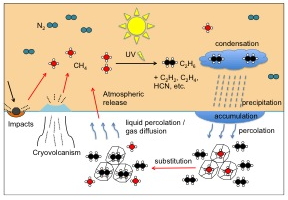2012 Annual Science Report
 NASA Jet Propulsion Laboratory - Titan
Reporting | SEP 2011 – AUG 2012
NASA Jet Propulsion Laboratory - Titan
Reporting | SEP 2011 – AUG 2012
Task 1.1.2.2 Models of the Reaction Between Hydrocarbons and Water Ice (Part 2)
Project Summary
In the clathrate phase, there can be an exchange between primordial methane clathrates, which are believed to make at least part of Titan’s upper crust, and ethane, which is the primary product of Titan’s atmospheric chemistry and is one of the major constituents of the lakes. Including these exchanges in a geophysical model of Titan allows explaining Titan’s shape as measured by the Cassini mission. These exchanges also may have an influence on Titan’s hydrocarbon cycle.
Project Progress
This year Colleague Choukroun and Co-Investigator Christophe Sotin investigated the exchanges in clathrate phase between primordial methane clathrates, which are believed to make at least part of Titan’s upper crust, and ethane, which is the primary product of Titan’s atmospheric chemistry and is one of the major constituents of the lakes. Including these exchanges in a geophysical model of Titan allowed explaining Titan’s shape as measured by Cassini. These exchanges may also have an influence on Titan’s hydrocarbon cycle.
From a thermodynamic standpoint, clathrate hydrates are stable on Titan throughout the interior. Thermal modeling also showed that ethane clathrate hydrates are more stable than methane clathrate hydrates from the surface to 10 km depth. Existing laboratory experiments had demonstrated that ethane, if present, would replace methane in the clathrate hydrates cages. Using these data, Choukroun and Sotin (2012) developed a kinetic model to investigate whether Titan’s cold conditions could preclude this exchange to occur. They have shown that, even at 92 K, this exchange can proceed to complete replacement of methane by ethane over geologic timescales.
Ethane precipitates to the surface primarily at Titan’s poles, owing to the atmospheric circulation. Ethane clathrates are denser than methane clathrates while occupying the same molecular volume, therefore the methane-ethane exchange would result in subsidence with respect to hydrostatic equilibrium. Choukroun and Sotin (2012) developed an isostatic compensation model, which translates the amounts of ethane that precipitate and percolate through the surface into a difference between polar and equatorial radii of Titan. As ethane is only produced by the photodissociation and recombination of methane in the upper atmosphere (which occur at known reaction rates, based on chemical modeling using Cassini data), the amounts of ethane needed to explain the radius difference corresponds directly to amounts of methane needed in the atmosphere to produce this ethane, and imply a timescale for ethane production.
This model shows that Titan’s shape can be explained by this process alone if it occurred over 300-1200 Myr, a timescale consistent with estimated surface age based on the cratering record, and based on isotopic composition of the atmospheric methane. Furthermore, each ethane molecule originated from two methane molecules, and may then substitute one methane molecule in clathrates in the subsurface. This is, therefore, a significant amount of methane that can be “recycled” into the atmosphere by this process. Thus this process can contribute significantly to Titan’s hydrocarbon, of which Choukroun and Sotin (2012) suggest a revision accordingly, see Figure 1.

Figure 1. Proposed revision of the hydrocarbon cycle on Titan, including methane substitution by ethane in subsurface clathrates
Publications
-
Choukroun, M., & Sotin, C. (2012). Is Titan’s shape caused by its meteorology and carbon cycle?. Geophysical Research Letters, 39(4), n/a–n/a. doi:10.1029/2011gl050747
-
PROJECT INVESTIGATORS:
-
PROJECT MEMBERS:
Christophe Sotin
Co-Investigator
-
RELATED OBJECTIVES:
Objective 2.2
Outer Solar System exploration
Objective 3.1
Sources of prebiotic materials and catalysts